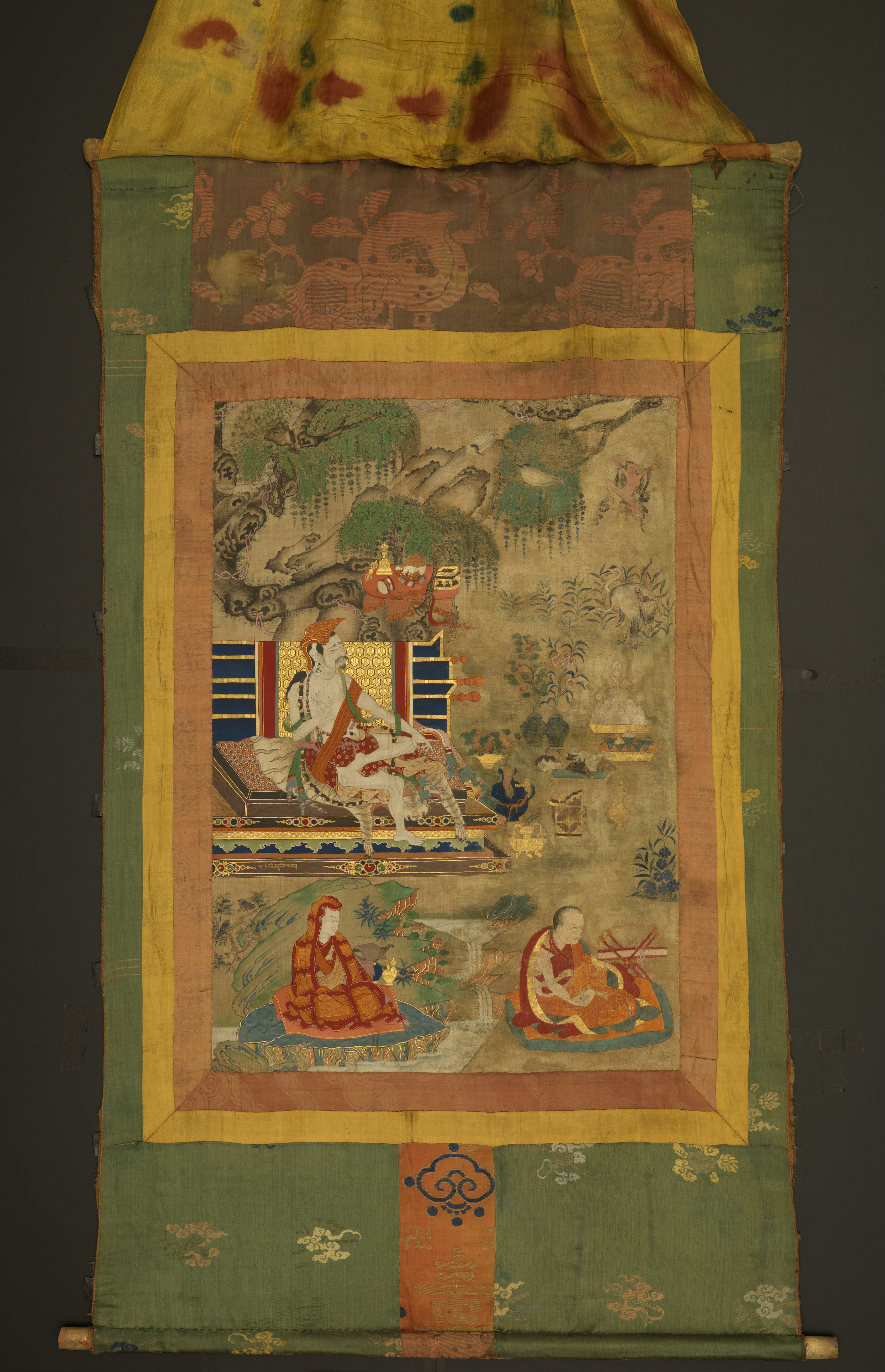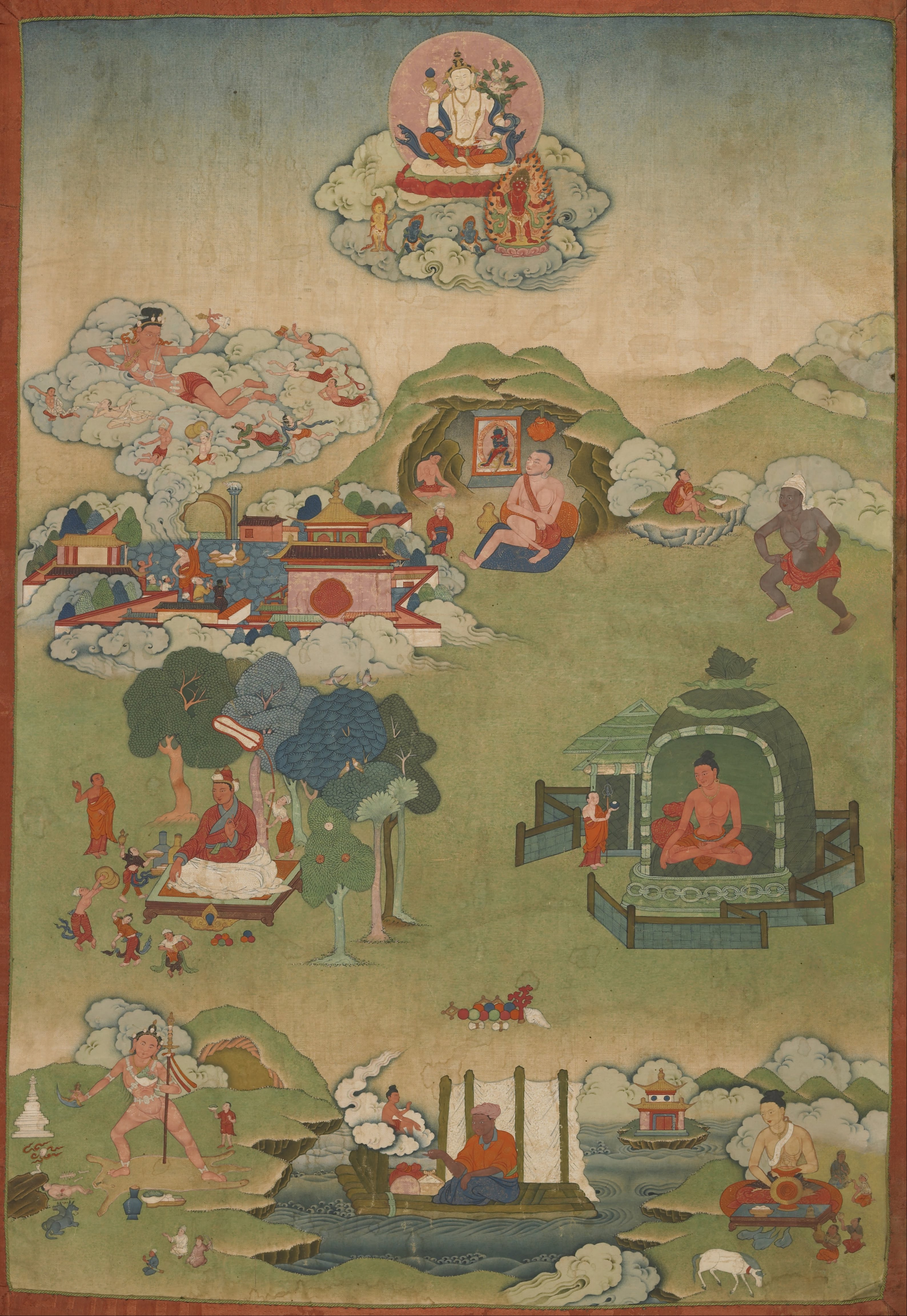|
Tilopa
Tilopa (Prakrit; Sanskrit: Talika or Tilopadā; 988–1069) was an Indian Buddhist tantric mahasiddha who lived along the Ganges River. He practised Anuttarayoga Tantra, a set of spiritual practices intended to accelerate the process of attaining Buddhahood. He became a holder of all the tantric lineages, possibly the only person in his day to do so. In addition to the way of insight and Mahamudra, Tilopa learned and passed on the Way of Methods (today known as the Six Dharmas of Naropa, Six Yogas of Naropa) and guru yoga. Naropa is considered his main student. Life Tilopa was born into the priestly Brahmin caste of Bengalis, Bengali origin in Eastern India. He adopted the monastery, monastic life upon receiving orders from a dakini (female buddha whose activity is to inspire practitioners) who told him to adopt a mendicant and itinerant minister, itinerant existence. From the beginning, she made it clear to Tilopa that his real parents were not the persons who had raised him bu ... [...More Info...] [...Related Items...] OR: [Wikipedia] [Google] [Baidu] |
Mahamudra
Mahāmudrā (Sanskrit: महामुद्रा, , contraction of ) literally means "great seal" or "great imprint" and refers to the fact that "all phenomena inevitably are stamped by the fact of wisdom and emptiness inseparable". Mahāmudrā is a multivalent term of great importance in later Indian Buddhism and Tibetan Buddhism which "also occurs occasionally in Hindu and East Asian Buddhist esotericism." The name also refers to a body of teachings representing the culmination of all the practices of the New Translation schools of Tibetan Buddhism, who believe it to be the quintessential message of all of their sacred texts. The practice of Mahāmudrā is also known as the teaching called " Sahajayoga" or "Co-emergence Yoga". In Tibetan Buddhism, particularly the Kagyu school, Sahaja Mahāmudrā is sometimes seen as a different Buddhist vehicle ( yana), the "Sahajayana" (Tibetan: ''lhen chig kye pa''), also known as the vehicle of self-liberation. Jamgon Kongtrul, a T ... [...More Info...] [...Related Items...] OR: [Wikipedia] [Google] [Baidu] |
Six Yogas Of Naropa
The Six Dharmas of Nāropa (, Skt. ''ṣaḍdharma'', "Naro's six doctrines" or "six teachings") are a set of advanced Tibetan Buddhist tantric practices compiled by the Indian mahasiddhas Tilopa and Nāropa (1016–1100 CE) and passed on to the Tibetan translator-yogi Marpa Lotsawa (). Another name for the six Dharmas is "the oral instruction transmission for achieving liberation in the bardo," or "the ''Bardo Trang-dol'' system". Bardo here, refers to the three bardos of waking, sleep and dying. They are also referred to as "the path of means" (''thabs lam'') in Kagyu literature.Kragh (2015), p. 345. They are also sometimes called the ''Six Yogas of Nāropa'' (though not in the traditional literature which never uses the term ''ṣaḍaṅga-yoga'' or ''sbyor-drug''). The six dharmas are a collection of tantric Buddhist completion stage practices drawn from the Buddhist tantras. They are intended to lead to Buddhahood in an accelerated manner. They traditionally require ... [...More Info...] [...Related Items...] OR: [Wikipedia] [Google] [Baidu] |
Six Dharmas Of Naropa
The Six Dharmas of Nāropa (, Sanskrit, Skt. ''ṣaḍdharma'', "Naro's six doctrines" or "six teachings") are a set of advanced Vajrayana Yoga, Tibetan Buddhist tantric practices compiled by the Indian mahasiddhas Tilopa and Nāropa (1016–1100 CE) and passed on to the Tibetan translator-yogi Marpa Lotsawa (). Another name for the six Dharma (Buddhism), Dharmas is "the oral instruction transmission for achieving liberation in the bardo," or "the ''Bardo Trang-dol'' system". Bardo here, refers to the three bardos of waking, sleep and dying. They are also referred to as "the path of means" (''thabs lam'') in Kagyu literature.Kragh (2015), p. 345. They are also sometimes called the ''Six Yogas of Nāropa'' (though not in the traditional literature which never uses the term ''ṣaḍaṅga-yoga'' or ''sbyor-drug''). The six dharmas are a collection of tantric Buddhist Deity yoga, completion stage practices drawn from the Tantras (Buddhism), Buddhist tantras. They are intended to le ... [...More Info...] [...Related Items...] OR: [Wikipedia] [Google] [Baidu] |
Naropa
Nāropā (Prakrit; , Naḍapāda or Abhayakirti) was an Indian Buddhism, Buddhist Mahasiddha. He was the disciple of Tilopa and brother, or some sources say partner and pupil, of Niguma. As an Indian Mahasiddha, Naropa's instructions inform Vajrayana, particularly his six yogas of Naropa relevant to the completion stage of anuttarayogatantra. He was also one of the "gatekeepers" of Vikramashila monastery which is located in Bihar. Although some accounts relate that Naropa was the personal teacher of Marpa Lotsawa, other accounts suggest that Marpa held Naropa's lineage through intermediary disciples only. Names According to scholar John Newman, "the Tibetans give Nāro's name as ''Nā ro pa, Nā ro paṇ chen, Nā ro ta pa,'' and so forth. The manuscript of the ''Paramarthasaṃgraha'' preserves a Sanskrit form ''Naḍapāda'' (''Paramarthasaṃgraha'' 74). A Sanskrit manuscript edited by Tucci preserves an apparent Prakrit form ''Nāropā'', as well as a semi-Sanskritic '' ... [...More Info...] [...Related Items...] OR: [Wikipedia] [Google] [Baidu] |
Mahasiddha
Mahasiddha (Sanskrit: ''mahāsiddha'' "great adept; ) is a term for someone who embodies and cultivates the "siddhi of perfection". A siddha is an individual who, through the practice of sādhanā, attains the realization of siddhis, psychic and spiritual abilities and powers. Mahasiddhas were practitioners of yoga and tantra, or ''tantrika''s. Their historical influence throughout the Indian subcontinent and the Himalayas was vast and they reached mythic proportions as codified in their songs of realization and hagiography, hagiographies, or Namtar (biography), namtars, many of which have been preserved in the Tibetan Buddhist canon. The Mahasiddhas are identified as founders of Vajrayana traditions and lineage (Buddhism), lineages such as Dzogchen and Mahamudra, as well as among Bon, Bön, Nath, Nāth, and Tamil Siddhar, siddhars, with the same Mahasiddha sometimes serving simultaneously as a founding figure for different traditions. Robert Thurman explains the symbiotic relati ... [...More Info...] [...Related Items...] OR: [Wikipedia] [Google] [Baidu] |
Dream Yoga
Dream yoga or ''milam'' (; , ''svapnadarśanayoga'')—the Yoga of the Dream State—is a suite of advanced tantric sadhana of the entwined Mantrayana lineages of Dzogchen ( Nyingmapa, Ngagpa, Mahasiddha, Kagyu and Bönpo). Dream yoga consists of tantric processes and techniques within the trance Bardos of Dream and Sleep () Six Dharmas of Naropa. In the tradition of the tantra, the dream yoga method is usually passed on by a qualified teacher to his/her students after necessary initiation. Various Tibetan lamas are unanimous that it is more of a passing of an enlightened experience rather than any textual information. The 'dream body' and the 'bardo body' have been identified with the 'vision body' (Tibetan: ''yid lus''): In the yoga of dreaming (''rmi lam, *svapna''), the yogi learns to remain aware during the states of dreaming (i.e. to lucid dream) and uses this skill to practice yoga in the dream. Bon Nyingma lineage The Nyingma lineage holds that there are 'Seven ... [...More Info...] [...Related Items...] OR: [Wikipedia] [Google] [Baidu] |
Indrabhuti
Indrabhuti (alternatively King Ja) is a name attributed to a number of individuals that have become conflated in Vajrayana Buddhism. One Indrabhuti, considered a Mahasiddha, was a disciple of Lawapa. Identities of the king Samten Karmay attempted to identify the different personages known as Indrabhutai. Conflation of Indrabhuti related to conflation of Oddiyana The matter of the conflation of Indrabhuti and at least one evocation of the historicity of a particular personage by that name is intimately connected with the location of ' Oddiyana' (the locality denoted by the term 'Oddiyana' whether in each case cited is Swat Valley or Odisha or some other location is glossed with a suite of orthographic representations and near homophones which require further case-by-case examination and exploration), Odisha and the cult of Jaganath and a number of texts that inform the matter such as the '' Sādhanamālā'', '' Kālikā Purāṇa'', '' Caturāsiti-siddha-Pravṛtti'', '' Jñā ... [...More Info...] [...Related Items...] OR: [Wikipedia] [Google] [Baidu] |
Phowa
''Phowa'' (, ) is a tantric practice found in both Hinduism and Buddhism. It may be described as "transference of consciousness at the time of death", " mindstream transference", "the practice of conscious dying", or "enlightenment without meditation" (). In Tibetan Buddhism phowa is one of the Six yogas of Naropa and also appears in many other lineages and systems of teaching. Lama Thubten Yeshe taught on the subject of phowa that "We have to choose the right time to transfer our consciousness; we’re not allowed to do it at the wrong time because that becomes suicide." Outside of Buddhism "This controversial esoteric technique (Skt. utkrānti), by which a tantric practitioner is able to sever his connection to the physical body, goes by the Indian reference to 'yogic' or spiritual suicide. It is referred to in many Saiva scriptures, in one Vaisnava Samhita, and a handful of Sākta Tantras. Application The method can be applied at the moment of death to, according to V ... [...More Info...] [...Related Items...] OR: [Wikipedia] [Google] [Baidu] |
Bengalis
Bengalis ( ), also rendered as endonym and exonym, endonym Bangalee, are an Indo-Aryan peoples, Indo-Aryan ethnolinguistic group originating from and culturally affiliated with the Bengal region of South Asia. The current population is divided between the sovereign country Bangladesh and the India, Indian regions of West Bengal, Tripura, Barak Valley of Assam, Andaman and Nicobar Islands, and parts of Meghalaya, Manipur and Jharkhand. Most speak Bengali language, Bengali, a classical languages of India, classical language from the Indo-Aryan languages, Indo-Aryan language family. Bengalis are the List of contemporary ethnic groups, third-largest ethnic group in the world, after the Han Chinese and Arabs. They are the largest ethnic group within the Indo-European languages, Indo–European linguistic family and the largest ethnic group in South Asia. Apart from Bangladesh and the Indian states of West Bengal, Tripura, Manipur, and Assam's Barak Valley, Bengali-majority popula ... [...More Info...] [...Related Items...] OR: [Wikipedia] [Google] [Baidu] |
Lawapa
Lawapa or Lavapa () was a figure in Tibetan Buddhism who flourished in the 10th century. He was also known as Kambala and Kambalapada (Sanskrit: ). Lawapa, was a mahasiddha, or accomplished yogi, who travelled to Tsari. Lawapa was a progenitor of the Dream Yoga sādhanā and it was from Lawapa that the mahasiddha Tilopa received the Dream Yoga practice lineage. Bhattacharya, while discussing ancient Bengali literature, proffers that Lawapa composed the '' Kambalagītika'' ( "Lawapa's Song") and a few songs of realization in the '' Charyapada''. Simmer-Brown (2001: p. 57) when conveying the ambiguity of ḍākinīs in their "worldly" and "wisdom" guises conveys a detailed narrative that provides the origin of Lawapa's name: Nomenclature, orthography and etymology Alternate English orthographies are Lwabapa, Lawapa and Lvapa. Simmer-Brown, Judith (2001). ''Dakini's Warm Breath: the Feminine Principle in Tibetan Buddhism''. Boston, USA: Shambhala. (alk. paper): p. 57; p. ... [...More Info...] [...Related Items...] OR: [Wikipedia] [Google] [Baidu] |
Tummo
In Tibetan Buddhism, ''tummo'' (; ) is the fierce goddess of heat and passion. Tummo is found in the Mahasiddha Krishnacarya and the '' Hevajra Tantra'' texts. Tummo is also a tantric practice for inner heat, developed around the concept of the female deity. It is found in the Six Dharmas of Naropa, Lamdre, Kalachakra, and Anuyoga teachings of Vajrayana. The purpose of tummo is to gain control over body processes during the completion stage of Anuyoga or Anuttarayoga Tantra ('highest yoga tantra'). The practice begins by visualizing the body's energy channels, winds, drops, and chakras. Inner heat, generated through specific breath-holding exercises, helps vital winds enter the central channel, leading to blissful experiences. The practice also involves focusing on seed syllables at the chakras and combining them with meditation on emptiness. Over time, practitioners aim to master this process, achieving heightened states of clarity, inner heat, and bliss. Scientifi ... [...More Info...] [...Related Items...] OR: [Wikipedia] [Google] [Baidu] |








